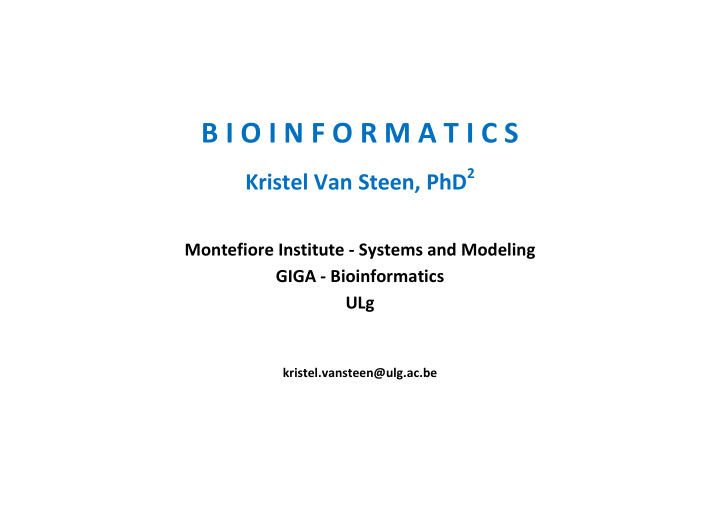



B I O I N F O R M A T I C S Kristel Van Steen, PhD 2 Montefiore Institute - Systems and Modeling GIGA - Bioinformatics ULg kristel.vansteen@ulg.ac.be
Bioinformatics Supplementary Chapter: Data basing SUPPLEMENTARY CHAPTER: DATA BASES AND MINING 1 What is a biological data base? 1.a Introduction 1.b Types of data bases 1.c Searching data bases K Van Steen 182
Bioinformatics Supplementary Chapter: Data basing 1 What is a biological data base 1.a Introduction • Over the past few decades, major advances in the field of molecular biology, coupled with advances in genomic technologies, have led to an explosive growth in the biological information generated by the scientific community. • The completion of a "working published in the February 15, 2001 issue of the journal Nature. draft" of the human genome -an important milestone in the Human Genome Project - was announced in June 2000 at a press conference at the White House and was K Van Steen 183
Bioinformatics Supplementary Chapter: Data basing The Human Genome Project K Van Steen 184
Bioinformatics Supplementary Chapter: Data basing Spin-offs of the Human Genome Project K Van Steen 185
Bioinformatics Supplementary Chapter: Data basing Explosive growth of data • In particular, advances in biotechnology and sequencing techniques lead to accumulation of biological data: - 100’s of mammalian genomes - SNP chips of 500,000 and above - Organism-wide gene expression profiles - Proteome snapshots characterizing translation products across time and tissues - Modeling of cellular processes (UIC Bioinformatics Group) and pathways K Van Steen 186
Bioinformatics Supplem mentary Chapter: Data basing EMBL data base growth th • This has led to an absolut olute requirement for computerized d ed databases to store, organize, and index dex the data and for specialized tools ools to view and analyze the data. K Van Steen 187
Bioinformatics Supplementary Chapter: Data basing What is a biological data base? • Biological data bases are libraries of life sciences information, collected from scientific experiments, published literature, high throughput experiment technology, and computational analyses. • They contain information from research areas including genomics, proteomics, metabolomics, microarray gene expression, and phylogenetics. • Information contained in biological databases includes gene function, structure, localization (both cellular and chromosomal), clinical effects of mutations as well as similarities of biological sequences and structures K Van Steen 188
Bioinformatics Supplementary Chapter: Data basing What is a biological data base? • A simple database might be a single file containing many records, each of which includes a overlapping “format” of information. . K Van Steen 189
Bioinformatics Supplementary Chapter: Data basing Desired properties of data bases For researchers to benefit from the data stored in a database, two additional requirements must be met: - easy access to the information - a method for extracting only that information needed to answer a specific biological question • Data must be in certain format for the programs to recognize them. • Every database can have its own format, but some data elements are essential for every database: - Unique identifier or accession code - Name of depositor - Literature reference - Deposition date - The real data K Van Steen 190
Bioinformatics Supplementary Chapter: Data basing Biological data bases: some statistics • More than 1000 different databases – 968 databases reported in The Molecular Biology Database Collection: 2007 update by Galperin, Nucleic Acids Research, 2007, Vol. 35, Database issue D3-D4 – Metabase: database of biological databases, http://biodatabase.org/index.php/Main_Page • Database sizes: <100kB to >100GB (EMBL >500GB) – DNA: >100GB – Protein: 1GB – 3D structure: 5GB • Update (adding new data) frequency: daily to annually • Freely accessible (as a rule) K Van Steen 191
Bioinformatics Supplementary Chapter: Data basing 1.b Types of data bases Primary data bases • Real experimental data • Biomolecular sequences or structures and associated annotation information: - organism, - function, - mutation linked to disease, - functional/structural patterns, - bibliographic, etc K Van Steen 192
Bioinformatics Supplementary Chapter: Data basing Examples of primary data bases • Sequence Information - DNA: EMBL nucleotide sequence data base, Genbank, DDBJ - Protein: SwissProt, TREMBL, PIR, OWL • Genome Information - GDB, MGD, ACeDB • Structure Information - PDB, NDB, CCDB/CSD K Van Steen 193
Bioinformatics Supplementary Chapter: Data basing Primary databases in detail: GenBank • GenBank is the NIH genetic sequence database • Genbank is an annotated collection of all publicly available DNA sequences (Nucleic Acids Research, 2008 Jan; 36(Database issue):D25-30). • It is connected to other data bases available at NCBI (National Center for Biotechnology Information). (http://www.ncbi.nlm.nih.gov/Genbank/genbankstats.html) K Van Steen 194
Bioinformatics Supplem mentary Chapter: Data basing NCBI (http://www.ncbi. cbi.nlm.nih.gov/) K Van Steen 195
Bioinformatics Supplementary Chapter: Data basing NCBI • Established in 1988 as a national resource for molecular biology information, NCBI creates public databases, conducts research in computational biology, develops software tools for analyzing genome data, and disseminates biomedical information - all for the better understanding of molecular processes affecting http://www.ncbi.nlm.nih.gov/About/ human health and disease. K Van Steen 196
Bioinformatics Supplementary Chapter: Data basing GenBank (http://www.ncbi.nlm.nih.gov/Genbank/index.html) K Van Steen 197
Bioinformatics Supplementary Chapter: Data basing GenBank sample record K Van Steen 198
Bioinformatics Supplementary Chapter: Data basing NCBI Resource Guide (http://www.ncbi.nlm.nih.gov/Sitemap/ResourceGuide.html) K Van Steen 199
Bioinformatics Supplementary Chapter: Data basing GenBank sample record information (http://www.ncbi.nlm.nih.gov/Sitemap/ResourceGuide.html#SampleRecord) K Van Steen 200
Bioinformatics Supplementary Chapter: Data basing GenBank sample record information (http://www.ncbi.nlm.nih.gov/Sitemap/samplerecord.html) K Van Steen 201
Recommend
More recommend